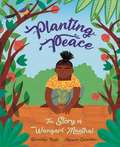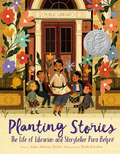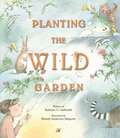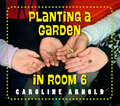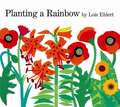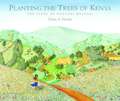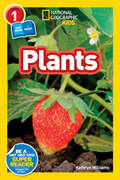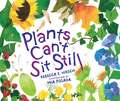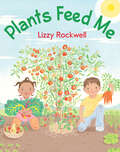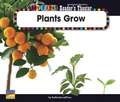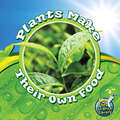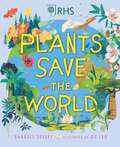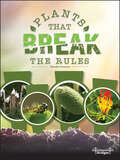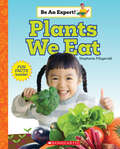- Table View
- List View
Planting Peace: The Story of Wangari Maathai
by Gwendolyn HooksThis is the inspiring story of Wangari Maathai, women's rights activist and one of the first environmental warriors. Overcoming great obstacles, Wangari began the Green Belt Movement in Kenya in the 1960s, which focused on planting trees, environmental conservation and women's rights. She inspired thousands across Africa to plant 30 million trees in 30 years, saving many from hunger and poverty. Her remarkable story of courage and determination shows how just one person can change the world.The story shows children how desertification works: how land is eroded and degraded when trees aren't there to hold the soil in place so it's not taken away by winds and heavy rain. It explains how all living things are dependent on each other and if trees are taken away, then you not only lessen the fertility of the soil, but you lose the animals that live there and then the animals that rely on those animals for food and so on.As well as explaining important green issues, the book also talks about Wangari's fight for human rights and shows how important it is to stand up for what you believe.The gripping narrative non-fiction text by Gwendolyn Hooks, winner of the NAACP Image Award for Outstanding Literary Work for Children, hooks readers from the start. Vibrant illustrations from print-maker Margaux Carpentier, one of the featured artists in Taschen's The Illustrator: 100 Best from around the World, vividly evoke Wangari's amazing life story.The consultant, Dr Jane Irungu, grew up in Kenya, but is now a Professor at the University of Oklahoma. She was inspired by Wangari when she was growing up and went on to get a PhD just as Wangari did. 'Carpentier's saturated geometric illustrations emphasize the bold impact of Maathai's actions', Publishers Weekly, May 2021
Planting Stories: The Life of Librarian and Storyteller Pura Belpré
by Anika Aldamuy DeniseRECIPIENT OF THE PURA BELPRÉ HONOR * A Today Show's Best Kids' Books of 2019 * Indie Next List Pick * Junior Library Guild Selection * “An appealing tribute and successful remedy to the lack of titles about the groundbreaking librarian...a must-have for all libraries.” —School Library Journal (starred review)An inspiring picture book biography of storyteller, puppeteer, and New York City’s first Puerto Rican librarian, who championed bilingual literature.When she came to America in 1921, Pura Belpré carried the cuentos folklóricos of her Puerto Rican homeland. Finding a new home at the New York Public Library as a bilingual assistant, she turned her popular retellings into libros and spread story seeds across the land. Today, these seeds have grown into a lush landscape as generations of children and storytellers continue to share her tales and celebrate Pura’s legacy.Brought to colorful life by Paola Escobar’s elegant and exuberant illustrations and Anika Aldamuy Denise’s lyrical text, this gorgeous book is perfect for the pioneers in your life.Informative backmatter and suggested further reading included.A Spanish-language edition, Sembrando historias: Pura Belpré: bibliotecaria y narradora de cuentos, is also available.“Anika Aldamuy Denise’s intimate telling captures the magical, folk-tale feeling of Belpré’s own stories. Her lyrical text, sprinkled like fairy dust with Spanish words, begs to be read aloud, while Paola Escobar’s stylishly detailed and warmly expressive illustrations capture the joy of sharing stories.” —New York Times Book Review
Planting a Garden in Room 6: From Seeds to Salad (Life Cycles in Room 6)
by Caroline ArnoldKindergarteners learn the joys of gardening in this close-up look at how plants grow.A visit to Mrs. Best's classroom is always inspiring! Follow a classroom of real kindergartners as they grow a garden full of healthy vegetables. Joyful photographs show kids planting seeds, tending the seedlings, and harvesting (and eating!) the results. An exciting introduction to the math and science involved in growing a garden. The Life Cycles in Room 6 series follows Mrs. Best&’s real kindergarten class as they help things grow. This photo-illustrated series engages readers with hands-on science in the classroom and beyond.
Planting a Rainbow (Fountas & Pinnell LLI Blue #Level F)
by Lois EhlertA mother and child plant a rainbow of flowers in the family garden.
Planting a Rainbow (Fountas & Pinnell LLI Blue: Level F)
by Lois EhlertThis educational and enjoyable book helps children understand how to plant bulbs, seeds, and seedlings, and nurture their growth. Lois Ehlert's bold collage illustrations include six pages that present all the flowers of each color of the rainbow.
Planting and Growing (Into Reading, Level E #26)
by Ken O'Donoghue Gail RileyNIMAC-sourced textbook
Planting the Trees of Kenya: The Story of Wangari Maathai
by Claire A. NivolaWangari Maathai, winner of the 2004 Nobel Peace Prize and founder of the Green Belt Movement, grew up in the highlands of Kenya, where fig trees cloaked the hills, fish filled the streams, and the people tended their bountiful gardens. But over many years, as more and more land was cleared, Kenya was transformed. When Wangari returned home from college in America, she found the village gardens dry, the people malnourished, and the trees gone. How could she alone bring back the trees and restore the gardens and the people? Bill McKibben, author of The End of Nature, says: “Wangari Maathai’s epic story has never been told better—-everyone who reads this book will want to plant a tree!” With glowing watercolor illustrations and lyrical prose, Claire Nivola tells the remarkable story of one woman’s effort to change the fate of her land by teaching many to care for it. An author’s note provides further information about Wangari Maathai and the Green Belt Movement. In keeping with the theme of the story, the book is printed on recycled paper.
Planting the Trees of Kenya: The Story of Wangari Maathai
by Claire A. NivolaWith glowing watercolor illustrations and lyrical prose, Claire Nivola tells the remarkable story of one woman's effort to change the fate of her land by teaching many to care for it. An author's note provides further information about Wangari Maathai and the Green Belt Movement. In keeping with the theme of the story, the book is printed on recycled paper.
Plantology: 30 Activities and Observations for Exploring the World of Plants (Young Naturalists)
by Michael Elsohn RossDID YOU KNOW...Scientists believe that mosses, the first plants, may have changed the Earth's climate from hot to cold by removing carbon dioxide from the atmosphere?Many members of the cabbage family release a poison "mustard" gas to fend off grazers?Plants are used in thousands of industries, from low-cost sewage treatment to new medical cures?Young nature enthusiasts will learn these and other fascinating facts about plants in this colorful, interactive resource. Plantology contains fun, kid-friendly discussions and activities to explore many topics—from seeds, roots, and sprouts to plant skeletons, leaves, petals, and fruits. It then goes beyond the basics to delve into the unknown world of common weeds, fascinating plant defense systems, and the countless roles plants play in our lives. With encouragement to "Try This," "Smell It," and "Look For," kids participate in 30 hands-on activities that promote observation and analysis, writing and drawing, math and science, and nature literacy skills. Children will keep a journal, examine and sketch plant structures, start a seed collection, make tasty vegetarian dishes, and more. Readers from any environment will start to notice the plants around them—not just in parks, gardens, and woods but also surrounding the schools, buildings, and sidewalks of their town, and in their own backyards. Useful resources include a glossary of scientific terms, a list of nature organizations and groups, and a teacher's guide to initiate classroom discussion and investigation.
Plants (National Geographic Kids Readers)
by Kathryn WilliamsAdult and child readers will learn all about plants together in this new Co-reader from National Geographic Kids. Find out how plants grow as well as the different parts of plants, seeds, and flowers.
Plants Bite Back!
by Richard PlattAt this level the Readers introduce more complex sentence structures and increased vocabulary. Archive photos and detailed illustrations make the stories exciting for children to read on their own.
Plants Can't Sit Still
by Mia Posada Rebecca E. HirschDo plants really move? Absolutely! You might be surprised by all ways plants can move. Plants might not pick up their roots and walk away, but they definitely don't sit still! Discover the many ways plants (and their seeds) move. Whether it's a sunflower, a Venus flytrap, or an exotic plant like an exploding cucumber, this fascinating picture book shows just how excitingly active plants really are.
Plants Everywhere (Fountas & Pinnell Classroom, Guided Reading Kindergarten)
by Madeline HydeNIMAC-sourced textbook
Plants Feed Me
by Lizzy RockwellSink your teeth into the plants that feed the world—flowers, fruits, seeds, and all! With its simple text and bright, appealing illustrations, this book is perfect for young readers learning about where their food comes from. Clearly-labeled diagrams show the different parts of plants we use and eat—leaves of spinach and cabbage, the roots of carrot plants, and the wide variety of fruits, such as apples, berries, and tomatoes. Plants Feed Me explores the different types of seeds we eat— beans, nuts, rice, and even how wheat is ground into flour and used to make many other types of food. Smiling children pick fruits and vegetables, and learn how plants grow from seeds, stretching toward the sky for sun and into the earth for nutrients. This celebration of fruits, vegetables, and more is sure to get kids interested in what's on their plates!
Plants Feed Me (Into Reading Texas, Read Aloud Module 8 #1)
by Lizzy RockwellNIMAC-sourced textbook
Plants Make Their Own Food (My Science Library)
by Julie LundgrenIntermediate Readers Learn About Photosynthesis.
Plants Save the World
by Annabel SaveryProduced in partnership with the RHS, Plants Save the World shows how plants are going to help us to SAVE the world!From tiny seeds and weeds to massive trees, plants come in all different shapes, sizes and colours. They can be found all over the world. In fact, they're so common, we hardly notice them at all. But plants are the foundation of all life on Earth - without them, we cannot survive! They provide food and medicine, clean the air we breathe, provide habitats for animals, protect against disasters, such as flooding, and are used to make products that we use every day. But plants are threatened by humans and so this book shows you how you can help to save them, too!Supports the science curriculum in the study of plant life cycles, plant parts, food chains, ecosystems, deforestation and habitats.In the accompanying book, Bugs Save the World, you can discover why bugs are so important to the survival of our planet, too.
Plants That Break the Rules (Nature's Rule Breakers)
by VizcarraNot all plants behave like plants. Did you know that some plants eat animals, and only sprout only after catching on fire? These plants are some of the weirdest but coolest plants in nature, and they're all inside this kids book about plant behavior. Why are they like this? Be a plant detective and find out in the Plants That Break the Rules Plant Book! Part of the Nature’s Rule Breaker’s Children’s Book Series, this 32-page nonfiction book explores weird but cool plant species that don't follow the rules of nature with fun-filled facts and vibrant photos that will prove just how unique these plants really are!Science Books for Kids Ages 8-12 Features:Comprehension questionsExtension activitySupports NGSS standardsAbout Rourke Educational Media:We proudly publish respectful and relevant nonfiction and fiction titles that represent our diverse readers, and are designed to support reading on a level that has no limits!
Plants That Move, Spin, and Snap (Fountas & Pinnell Classroom, Guided Reading)
by Zeke ShepherdNIMAC-sourced textbook. Plants in Action. Plants can't get up and walk away. But that doesn't stop them from moving to get what they need.
Plants We Eat (Be an Expert!)
by Stephanie FitzgeraldKids love to be the experts! Now they can feel like real pros with this exciting nonfiction series for beginning readers. Kids will be hooked on the thrilling real-world topics and big, bright photos. Each book features simple sentences and sight words that children can practice reading. Then, with support, kids can dig deeper into the extra facts, Q&As, and fun challenges.Fans of this series will be eager to become real experts!Sometimes we eat the leaves of a plant. Sometimes we eat the roots. These foods from plants are all good for us! What do you know about the fruits and vegetables that come from plants? With this book you can become an expert!
Plants We Use (Into Reading, Level K #89)
by Lisa ShulmanWe use plants to make books, clothing, and other things. Find out how we use different parts of plants to make the things we need.
Plants and Fungi (A Whole World of... #5)
by Anna ClaybourneGet lost in the diverse and beautiful world of plants and fungi - with more to explore than you ever imagined!A Whole World of Plants and Fungi presents the stunning breadth of plant and fungus varieties that fill the Earth. What is the difference between a plant and a fungus? What exactly is the purpose of a pine cone? Which plants can survive in the driest deserts, and which prefer the hot, humid tropics? This book has the answers and so many more facts filling the beautifully illustrated pages.A Whole World of is a book series looking at the extraordinary diversity of life on Earth - the defining features and evolutionary branches - and encourages readers age 7 and up to consider why it is important to maintain biodiversity. Written by award-winning author, Anna Claybourne, with artwork by award-winning illustrator, Yekyung Kwon.Books in the series:A Whole World of Mammals/A Whole World of Prehistoric Life/A Whole World of Minibeasts/A Whole World of Birds/A Whole World of Rocks and Minerals/A Whole World of Plants and Fungi
